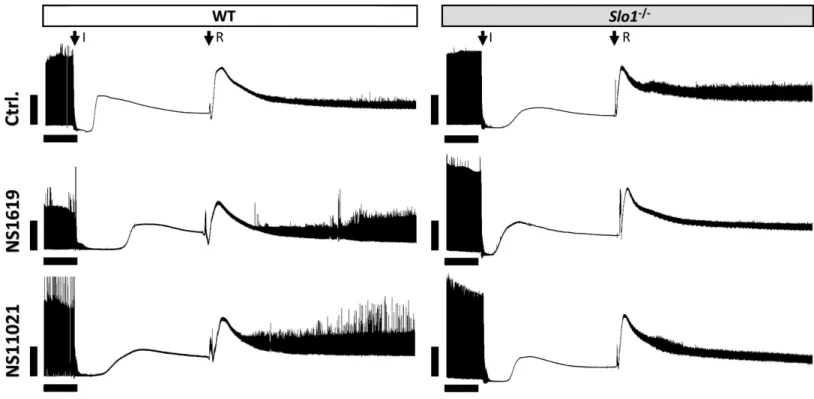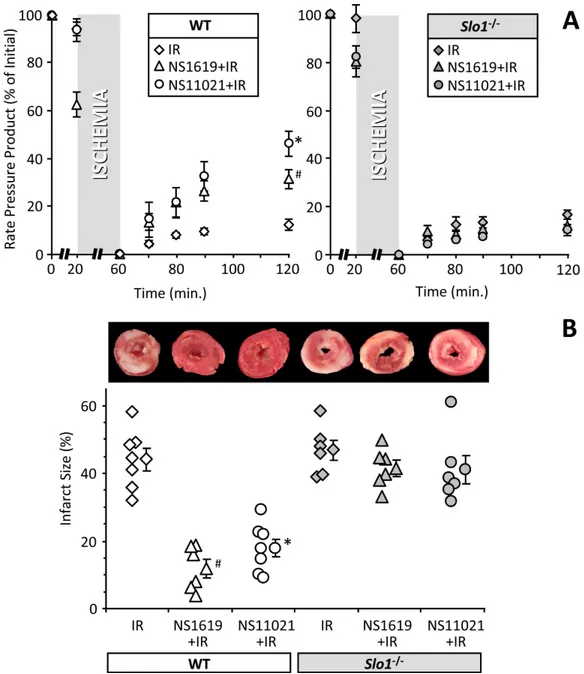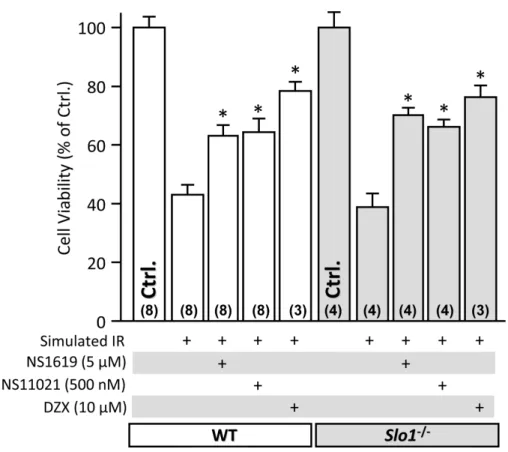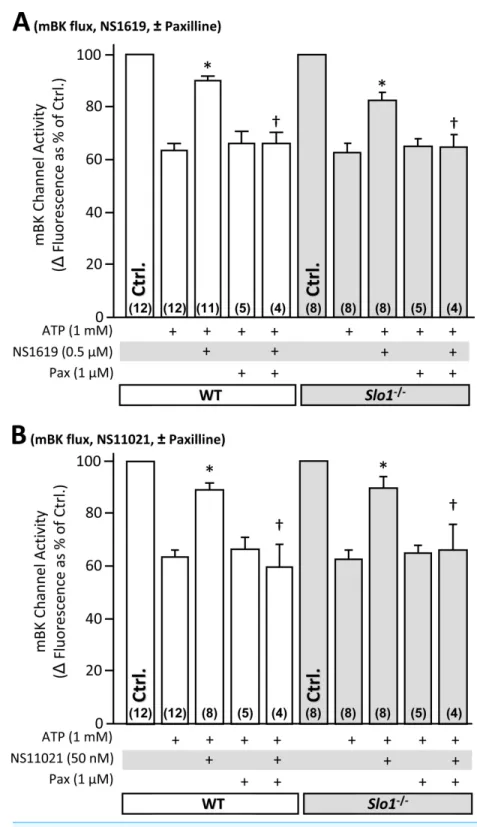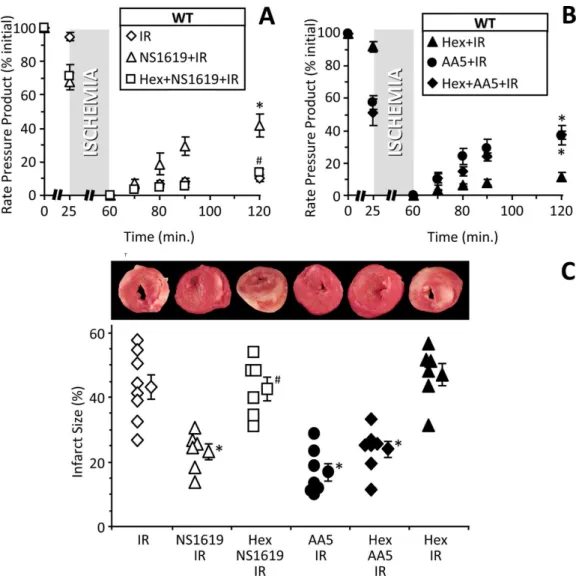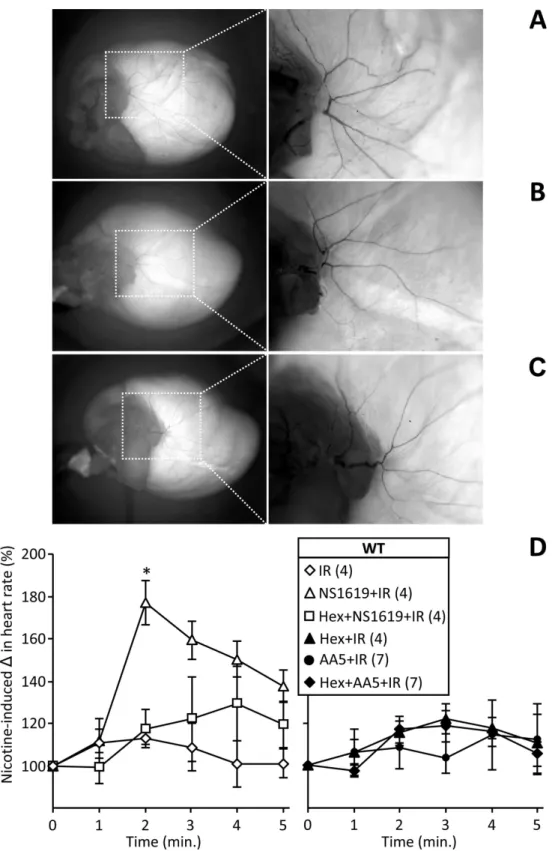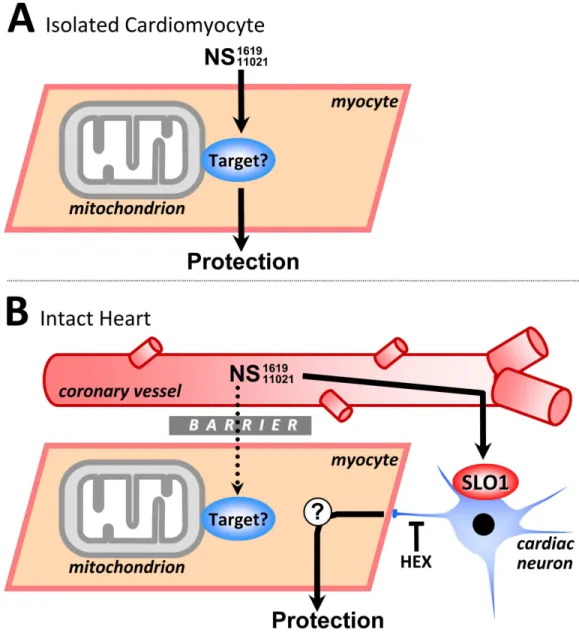Submitted3 January 2013 Accepted 19 February 2013 Published5 March 2013
Corresponding author
Paul S. Brookes,
paul brookes@urmc.rochester.edu
Academic editor
Lai-Hua Xie
Additional Information and Declarations can be found on page 17
DOI10.7717/peerj.48
Copyright
2013 Wojtovich et al.
Distributed under
Creative Commons CC-BY 3.0
OPEN ACCESS
A non-cardiomyocyte autonomous
mechanism of cardioprotection involving
the SLO1 BK channel
Andrew P. Wojtovich1, Sergiy M. Nadtochiy2, William R. Urciuoli2, Charles O. Smith3, Morten Grunnet4,5, Keith Nehrke1and
Paul S. Brookes2
1Department of Medicine, University of Rochester Medical Center, Rochester, NY, USA 2Department of Anesthesiology, University of Rochester Medical Center, Rochester, NY, USA 3Department of Biochemistry, University of Rochester Medical Center, Rochester, NY, USA 4Lundbeck AS, Valby, Denmark
5Acesion Pharma, Copenhagen, Denmark
ABSTRACT
Opening of BK-typeCa2+activatedK+channels protects the heart against ischemia-reperfusion (IR) injury. However, the location of BK channels responsible for cardioprotection is debated. Herein we confirmed that openers of the SLO1 BK channel, NS1619 and NS11021, were protective in a mouse perfused heart model of IR injury. As anticipated, deletion of theSlo1gene blocked this protection. However, in an isolated cardiomyocyte model of IR injury, protection by NS1619 and NS11021 was insensitive toSlo1deletion. These data suggest that protection in intact hearts occurs by a non-cardiomyocyte autonomous, SLO1-dependent, mechanism. In this regard, anin-situassay of intrinsic cardiac neuronal function (tachycardic response to nicotine) revealed that NS1619 preserved cardiac neurons following IR injury. Furthermore, blockade of synaptic transmission by hexamethonium suppressed cardioprotection by NS1619 in intact hearts. These results suggest that opening SLO1 protects the heart during IR injury, via a mechanism that involves intrinsic cardiac neurons. Cardiac neuronal ion channels may be useful therapeutic targets for eliciting cardioprotection.
Subjects Biochemistry, Cardiology
Keywords Large conductance potassium channel, Ischemia, Reperfusion, Preconditioning, Cardiac neurons, NS1619, NS11021
INTRODUCTION
All tissues, including the heart, possess endogenous mechanisms to protect against ischemia-reperfusion (IR) injury, and the opening ofK+channels is central to many cardioprotective paradigms including ischemic preconditioning (IPC) and anesthetic pre-conditioning (APC) (Facundo, Fornazari & Kowaltowski, 2006). The mitochondrialKATP
and although a channel resembling SLO1 (KCa1.1, KCNMA1) has been reported in mitochondria (Siemen et al., 1999), gene deletion experiments show thatSlo1is not required for cardioprotection by IPC or APC (Wojtovich et al., 2011).
Despite ongoing debate regarding the identity of a mitochondrial BK channel, it is widely reported that SLO1 is expressed in the heart (Chen et al., 2005;Jiang et al., 1999; Tseng-Crank et al., 1994). Furthermore, SLO1 activation by small molecules such as NS1619 and NS11021 is cardioprotective (Xu et al., 2002;Bentzen et al., 2007). SLO1 is not found at the cardiomyocyte plasma membrane (Xu et al., 2002), but SLO1 channel activity has been reported in intra-cardiac neurons (Franciolini et al., 2001) and Purkinje fibers (Callewaert, Vereecke & Carmeliet, 1986), where it is thought to play a role in regulating heart rate (Imlach et al., 2010).
Despite the assumption that NS1619 and NS11021 protect via a (mitochondrial) SLO1 (Xu et al., 2002), many non-specific effects such as opening of other ion channels (Park et al., 2007;Saleh et al., 2007;Holland et al., 1996) and inhibition of mitochondrial function (Aldakkak et al., 2010;Aon et al., 2010;Cancherini, Queliconi & Kowaltowski, 2007;Debska et al., 2003;Kicinska & Szewczyk, 2004) have been reported for these compounds, and a pharmaco-genomic study has not been conducted. Such SLO1-independent effects could underlie the cardioprotective benefit of these com-pounds (Cancherini, Queliconi & Kowaltowski, 2007;Kicinska & Szewczyk, 2004), and herein we sought to investigate the contribution of SLO1 to the cardioprotection elicited by NS1619 and NS11021, including studies inSlo1−/−mice to control for off-target effects. We report on the discovery of a non-cardiomyocyte autonomous mechanism of cardioprotection involving SLO1 and intrinsic cardiac neurons.
MATERIALS & METHODS
Reagents, animals
NS11021 was a gift from Neurosearch A/S (Ballerup, Denmark). All other chemicals were of the highest grade available from Sigma (St. Louis, MO) unless otherwise specified.Slo1−/−(KCNMA1−/−)mice were generated on the FVB background via deletion of Exon1, which contains the translation start site and the S0 trans-membrane segment (Meredith et al., 2004). This results in both transcripts and protein being undetectable, and it has been previously shown that the lack of an S0 domain results in a nonfunctional BK channel (Zarei et al., 2001;Zarei et al., 2004). Animals were genotyped by tail biopsy PCR, as previously described (Meredith et al., 2004). All experiments used male WT andSlo1−/−littermates age 6–8 weeks. Mice were maintained in an AAALAC-accredited pathogen-free barrier facility with food and water availablead libitum. All procedures were in accordance with the NIHGuide for the Care and Use of Laboratory Animals(2011 revision) and were approved by the University Committee on Animal Resources.
Mouse Langendorffex-vivo perfused heart
Following avertin anesthesia, a thoracotomy was performed, the aorta cannulated
(Wojtovich et al., 2011;Nadtochiy et al., 2009). The heart was perfused with Krebs-Henseleit buffer in constant flow mode (4 ml/min). The following experimental protocols were observed: (i) IR injury: 20 min normoxic perfusion, 40 min global ischemia, 60 min reperfusion. (ii) NS1619+IR: 10 min normoxic perfusion, 10 min of5µMNS1619, 30 s washout, then IR as above. (iii) NS11021+IR: 10 min normoxic perfusion, 10 min of 500 nM NS11021, 30 s washout, then IR as above.
Studies involving hexamethonium were independently controlled and the following experimental protocols were observed: (iv) IR injury: 25 min normoxic perfusion, 35 min global ischemia, 60 min reperfusion. (v) NS1619+IR: 15 min normoxic perfusion, 10 min of5µMNS1619, 30 s washout, then IR as above. (vi) NS1619+IR+Hexamethonium: 12.5 min normoxic perfusion, 2.5 min of500µMhexamethonium, 10 min of5µM NS1619 plus500µMhexamethonium, 30 s washout of NS1619 only, 35 min global ischemia, 5 min reperfusion plus500 µMhexamethonium, 55 min reperfusion. (vii) Atpenin A5 (AA5)+IR: 5 min normoxic perfusion, 20 min of 10 nM AA5, 30 s washout, then IR as above. (viii) AA5+IR+Hexamethonium: 2.5 min normoxic perfusion, 2.5 min of500µMhexamethonium, 20 min of 10 nM AA5 plus500µMhexamethonium, 30 s washout of AA5 only, 35 min global ischemia, 5 min reperfusion plus500µM hexamethonium, 55 min reperfusion. Note that different ischemic times (35 vs. 40 min) were used to ensure adequate independent controls for every group examined.
To assess neuronal survival, hearts were exposed to100µMnicotine for 5 min following the reperfusion period. Compounds were delivered via a syringe pump linked to an injection port immediately above the perfusion cannula. The volume of added solutions was≤0.05% of the total perfusate volume. Following experimental protocols, hearts were TTC stained and imaged as previously described to quantify infarct size (Wojtovich et al., 2011;Nadtochiy et al., 2011).
Mouse cardiomyocyte isolation
Following avertin anesthesia, the aorta was cannulatedin-situand the heart rapidly transferred to perfusion apparatus. The heart was perfused for 3 min with a modified Krebs-Henseleit “buffer A” (118 mM NaCl, 4.7 mM KCl, 1.2 mMKH2PO4, 1.2 mM
MgSO4, 10 mM HEPES, 24 mMNaHCO3, 5.5 mM glucose, bubbled with 95%O2, 5% CO2, pH 7.35, 37◦C) at 3 ml/min to remove blood. The heart was then perfused with digestion buffer (buffer A plus 0.25 mMCaCl2, 30 mM taurine, 10 mM 2,3-butanedione monoxime, 0.0278% Trypsin, 25 mg collagenase A, 75 mg collagenase D) at 3 ml/min for 12 min. The heart was removed and teased apart with forceps. Tissue was dispersed with 10 ml stop buffer (buffer A plus12.5µM CaCl2, 10% FBS) with a transfer pipette, then
passed through a200µmfilter. Myocytes were settled by gravity for 10 min, supernatant removed, and pellet resuspended in 10 ml stop buffer.Ca2+was gradually increased from
viability determined by Trypan blue exclusion. One mouse heart typically yielded1.2×106
cells (75% viable) and cells were used for simulated IR injury immediately after isolation.
Mouse cardiomyocyte simulated IR injury
Myocytes were equilibrated at a concentration of105cells/ml for 10 min in normoxic buffer. Incubations were in 50 ml round-bottom tubes in a shaking water bath (80 cycles/min) at 37◦C. Myocytes were divided in to the following groups (i) Control, 100 min in normoxic buffer; (ii) Simulated ischemia-reperfusion (SIR), 10 min normoxic buffer, then 1 h ischemia buffer (118 mM NaCl, 4.7 mM KCl, 1.2 mMKH2PO4, 1.2 mM
MgSO4, 10 mM HEPES, 24 mMNaHCO3, 0.25 mMCaCl2, 10% FBS, gassed with 95%N2, 5%CO2, pH 6.5, 37◦C), followed by 30 min normoxic buffer; (iii)Drug+SIR, comprising
treatment with compounds 10 min prior to SIR in normoxic buffer, then 1 h ischemia buffer, 30 min normoxic buffer. Drugs tested (final concentrations in parentheses) were: NS1619 (5µM), NS11021 (500 nM) and diazoxide (10µM). Drugs were dissolved in DMSO and the vehicle comprised<0.1% of total incubation volume. DMSO was included in the control and SIR groups at the appropriate times. To change buffers, cells were centrifuged at31×gfor 2 min, and the pellet resuspended in the appropriate buffer. At the end of protocols, viability was determined by Trypan blue exclusion.
Isolated mitochondrial BK channel activity
Mitochondria were isolated from 3 mouse hearts as previously described (Wojtovich et al., 2010). The mitochondria were incubated with20µMBTC-AM and 0.05% Pluronic F-127 for 10 min at room temperature. The final mitochondrial pellet was suspended in225µl and stored on ice until use, within 1.5 hTl+uptake into mitochondria was measured using a Varian Cary Eclipse spectrofluorimeter as previously described (Wojtovich et al., 2010) by monitoring changes in BTC fluorescence (λEX488 nm,λEM525 nm). Where indicated,
ATP (to blockmKATPchannel), NS compounds (to open mBK channels) and paxilline (to block BK channels) were present at concentrations indicated.
Total heart histochemical acetylcholinesterase staining
Following IR protocols as described above, hearts were perfused with 10 mM phosphate buffered saline (PBS; pH 7.4 at 25◦C) for 3 min at 4 ml/min. Control hearts not exposed to IR injury were cannulated and perfused with PBS. Hearts were then stained for acetyl-cholinesterase (Rysevaite et al., 2011). Hearts were prefixed with 4% formalin for 30 min at 4◦C, then washed with PBS and incubated in PBS supplemented with hyaluronidase (0.5 mg/100 ml) for 18 h at 4◦C. The hearts were then placed in Karnovsky-Roots medium (60 mM sodium acetate, 2 mM acetylthiocholine iodide, 15 mM sodium citrate, 3 mM
CuSO4, 0.5 mMK3Fe(CN)6, 0.1% trition-X 100, 0.5 mg/100 ml hyaluronidase, pH 5.6 at
Statistics
Data presented are means±SEM. Statistical significance (p<0.05) between multiple groups was determined using analysis of variance (ANOVA) with Bonferroni correction. Mixed effects models were generated using “R” software (R Development Core Team) and the R packages lme4 (Bates & Maechler, 2009) and languageR (Baayen, 2008;Baayen, 2009). As fixed effects, we included treatment conditions, genotype, and their interaction in the model. Normality and homogeneity were checked using visual inspections of plots of residuals against fitted values. Likelihood ratio tests comparing the models with fixed effects to the null models using only random effects, were used to assess the accuracy of the mixed effects models. The model was further analyzed using pair wise comparisont-test. We rejected results where the model including fixed effects did not differ significantly from the null model. For all mixed effects models we present MCMC-estimatedp-values that are considered significant at theα <0.05level.
RESULTS
Protection of intact hearts by NS1619 and NS11021 requires Slo1 Previously we showed that cardioprotection by both IPC and APC in intact hearts is SLO1 independent (Wojtovich et al., 2011). However, the SLO1 openers NS1619 and NS11021 are still reported to protect against IR injury in intact hearts (Bentzen et al., 2009;Xu et al., 2002), suggesting that SLO1 alone can afford protection. To examine the pharmaco-genomics of SLO1, NS1619 and NS11021 in more detail, we utilized anex-vivo
perfused heart model of IR injury. Representative raw data tracings of cardiac function during IR injury are shown inFig. 1. Hearts from WT andSlo1−/−mice exhibited similar sensitivity to IR (quantitative data shown inFig. 2), and as previously reported both NS1619 and NS11021 protected the WT heart from IR injury (enhanced functional recovery and reduced infarct size), with NS11021 being 10-fold more potent than NS1619. As anticipated, protection was lost inSlo1−/−hearts, suggesting that SLO1 is abona-fide
target for the cardioprotective effects of NS1619 and NS11021 in the intact heart. While it is possible that SLO1 is merely a downstream mediator of protection by NS1619 and NS11021, Occam’s razor would suggest SLO1 is the actual target.
Protection of isolated cardiomyocytes by NS1619 and NS11021 is Slo1 independent
Figure 1 Representative left ventricular pressure traces from perfused hearts.Traces are shown for wild-type (WT) andSlo1−/−hearts, in the presence of vehicle (Ctrl.), NS1619 or NS11021, as per the methods. Traces are compressed on the time (x) axis. The top and bottom boundaries of the black shaded area represent the systolic and diastolic pressures, respectively. The onset of ischemia (I) and reperfusion (R) are indicated by arrows. Scale bars on each trace represent 10 min. (x-axis) and 50 mmHg (y-axis).
protective in both WT andSlo1−/−cells. Overall these data suggest that the protection of cardiomyocytes by NS1619 and NS11021 may be due to off-target (non-SLO1) effects of these molecules, as reported elsewhere (Park et al., 2007;Saleh et al., 2007;Holland et al., 1996;Aldakkak et al., 2010;Aon et al., 2010;Cancherini, Queliconi & Kowaltowski, 2007; Debska et al., 2003;Kicinska & Szewczyk, 2004).
NS1619 and NS11021 exhibit Slo1 independent effects on isolated mitochondria
To directly test whether NS1619 and NS11021 were able to activate BK channels in isolated mitochondria, a modified thallium (Tl+) flux assay was utilized (Wojtovich et al., 2010). As expected, both compounds were able to elicit aTl+flux, in a manner sensitive to the BK channel blocker paxilline (Fig. 4). However, this flux was evident in mitochondria derived from both WT andSlo1−/−hearts, indicating it did not originate at the level of SLO1. Furthermore, bona fide mitochondrialK+channels exhibit a slowing ofTl+flux kinetics by increasing concentrations ofK+and notNa+(since onlyK+competes for
Figure 3 SLO1 independent protection of adult mouse cardiomyocytes against simulated ischemia-reperfusion (IR) injury.Myocytes were isolated from adult littermate WT (white) andSlo1−/−(gray) mouse hearts, and used immediately in the model of IR injury. Where indicated, cells were treated with NS1619 (5µM), NS11021 (500 nM) or diazoxide (DZX,10µM). Upon completion of the IR protocol, cell viability was measured via Trypan blue exclusion and expressed as a percent of control (viability in control normoxic groups was: WT70±3%,Slo1−/−69±4%). Experimental conditions are listed below thex-axis. Data are means±SEM, withNfor each group listed in parentheses at the base offeach bar. EachNrepresents an independent cardiomyocyte preparation. *p<0.05vs. IR alone (ANOVA).
SLO1 dependent protection in intact hearts requires cardiac neu-ronal function
Figure 4 SLO1 independent K+channel activity in isolated mouse heart mitochondria. Mitochon-dria were isolated from littermate WT (white) and Slo1−/− (gray) mouse hearts and loaded with
Figure 4 (...continued)
presented as1fluorescence uponTl+addition to media. ATP was present to block themKATPchannel. The baseline1fluorescence (Ctrl, set to 100%) was24.7±2.3and24.9±4.4arbitrary units in WT (white bars) andSlo1−/−(gray bars), respectively. Experimental conditions are listed below thex-axis. Data are means±SEM, withNfor each group listed in parentheses at the base offeach bar. EachN
represents an independent mitochondrial preparation. Control, ATP andATP+Paxdata are replicated between panels A and B for comparison *p<0.05vs. ATP,†p<0.05vs. ATP + NS compound (ANOVA).
Figure 5shows that blockade of neuronal function with the synaptic transmission in-hibitor hexamethonium, prevented cardioprotection (reduction in infarct size) by NS1619 in intact hearts. This effect was specific to SLO1 and NS1619, since hexamethonium had no effect on protection afforded by the mitochondrialKATPchannel activator atpenin A5 (Wojtovich & Brookes, 2009). These data also indicate that NS1619 protects via a mechanism that is distinct from mitochondrialKATPchannel opening.
To further investigate the role of cardiac neurons in protection afforded by SLO1 activators, we assessed neuronal status by histochemical staining for acetylcholinesterase activity (AChE). No differences in AChE staining were found between control, IR, and
IR+NS1619hearts, suggesting the acute time frame of IR injury in this model was not sufficient to precipitate neuronal loss (Fig. 6A–C). We therefore hypothesized that a more direct test of cardiac neuronal function might be necessary to assess neuronal protection in this acute model. Hence, the response of heart rate to nicotine (which induces transient tachycardia via nicotinic Ach receptors (Tosaka et al., 2003;Haass & Kubler, 1997)) was measured after IR injury. As seen inFig. 6D, no response to nicotine was seen in control hearts subjected to IR, indicating loss of neuronal function. However, hearts protected with NS1619 exhibited a robust post-IR nicotine response, and this effect was blocked by pre-treatment with hexamethonium, indicating a preservation of nicotine-sensitive intrinsic cardiac neurons. Notably, hearts protected with themKATPopener atpenin A5 did not exhibit a preserved nicotine response. This is consistent with the data inFig. 4
showing that even though atpenin A5 was protective, this cardioprotection was insensitive to hexamethonium. Overall these data indicate that bothmKATPand SLO1 channels can protect the heart (Figs. 1,2and5), but they do so via distinct mechanisms, the latter requiring cardiac neuron function.
DISCUSSION
Together, the current data suggest that the SLO1 openers NS1619 and NS11021 act to preserve intrinsic cardiac neuronal function in IR injury, in aSlo1dependent manner, and this leads to protection of myocardium. As such, the function of cardiomyocytes in IR injury can be preserved by activation of a non-cardiomyocyte-autonomous signaling mechanism. From a pharmaco-genomic perspective, this is the first study to show that cardioprotection in the intact heart by the putative SLO1 activators NS1619 and NS11021 actually requires theSlo1gene product (Figs. 1and2).
Figure 5 Blocking cardiac neuronal function blocks SLO1 dependent protection in the intact heart.(A, B): Perfused FVB mouse hearts from WT animals were subjected to IR injury. Where indicated, hearts were treated with NS1619 (5µM), atpenin A5 (AA5, 10 nM), or hexamethonium (Hex,500µM) as detailed in the methods. Left-ventricular function was determined as rate pressure product (RPP; heart rate x left ventricular developed pressure) and expressed as a percent of initial value. Data are split across two panels for clarity. Statistical significance between groups was determined using a mixed-effects model. *p<0.05vs. IR alone, #p<0.05vs.NS1619+IR. (C): Following IR protocols, hearts were sliced, stained with TTC and fixed to delineate live (red) from dead or infarcted tissue (white). Infarcts were quantified by planimetry and expressed as a percent of the area at risk (100% in this global ischemia model). Images above the graph show representative slices from each group. Within each group, individual values are on the left, and means±SEM on the right (N=8for IR, 7 forAA5+IR, and 6 for all other groups). *p<0.05vs. IR alone, #p<0.05vs.NS1619+IR.
Figure 6 (...continued)
(Hex,500µM), or combinations ofNS1619+HexorAA5+Hex, as detailed in the methods. Panels A–C show representative total heart histochemical acetylcholinesterase (AChE) staining following (A) control perfusion, (B) IR injury and (C) IR with NS1619 pre-treatment. Dorsal side of the heart is shown, with magnifications of boxed areas shown in right panels. (D): Functional activity of cardiac neurons was determined following the six IR protocols used inFig. 3, via the injection of nicotine (100µM) for 5 min. The peak heart rate increase was found at 2 min, followed by desensitization and subsequent decrease in heart rate. Data are means±SEM.Nfor each group is shown in parentheses to the right of the legend. EachNrepresents an individual perfused heart. *p<0.05vs. IR (ANOVA).
channels (e.g., by diazoxide or atpenin A5), and suggests that non-myocyte and possibly non-mitochondrialK+channels are also important in determining responses to ischemia.
The data inFigs. 5and6suggest that cardioprotection by SLO1 activators proceeds via intrinsic cardiac neurons, with preservation of neuronal function during IR injury leading to improved cardiac functional recovery, decreased infarct size (Fig. 5), and the post-IR ability to mount a tachycardic response to nicotine (Fig. 6D). This nicotine response requires both intact cardiac neurons and the ability of myocytes to respond to a tachycardic signal. Notably, hearts protected bymKATPagonist atpenin A5 were fully competent at the
contractile level post-IR (Fig. 5), but failed to respond to nicotine. This suggests a post-IR defect in a non-cardiomyocyte cell-type, presumably neurons since this is the only other cell type known to be involved in the nicotine response. Post-IR in NS1619 treated hearts responded to nicotine in a manner that was blocked by hexamethonium (Fig. 6D), and the preservation of contractile function by NS1619 was also blocked by hexamethonium (Fig. 5).
Overall, the most logical explanation for these data is that NS1619 protection proceeds via SLO1 in cardiac neurons. However, we cannot rule out the possibility that NS1619 acts on other neuronal targets. Unfortunately this cannot be tested experimentally using Slo1−/−mice, because post-IRSlo1−/−hearts treated with NS1619 are incompetent at the contractile level (Figs. 1and2), so they cannot respond to nicotine anyway, regardless of their neuronal status. Clearly, cardiomyocyte- or neuron-specificSlo1−/−animals would be of enormous benefit in further elucidating the protective mechanism of the NS compounds in future.
Figure 7 Working model of SLO1 (in)dependent mechanisms of action in NS1619/NS11021 cardio-protection.(A): In isolated cardiomyocytes the NS compounds induce cardioprotection independent of SLO1. The ‘target’ remains unclear but may include inhibition of respiration or the uncoupling of oxidative phosphorylation (see text for details). This mechanism is compatible with the lack of evidence for SLO1 in cardiomyocytes. (B): In the whole heart, cardioprotection by NS1619/NS11021 is dependent on SLO1 and is likely mediated via a cell non-autonomous mechanism, involving intrinsic cardiac neurons. A barrier is hypothesized to exist, possibly accounting for the inability of NS compounds to recruit the nonspecific target responsible for protection in myocytes. This explains the lack of ability of NS1619/NS11021 to protect the intactSlo1−/−heart.HEX=hexamethonium.
associated with ischemic events (Gribkoffet al., 2001). In simple terms, the NS compounds may prevent excitotoxicity. The ability to modulate cardiac neuronal activity in this manner is a promising therapeutic avenue for ischemic injury (Armour, 1999). Recently, several non-myocyte cell types in the heart have emerged as key players in the response to ischemic injury, including cardiac fibroblasts (Kawaguchi et al., 2011), cardiac mast cells (Reid et al., 2011;Koda et al., 2010), and cardiac stem/progenitor cells (Shah et al., 2011). At this stage, it is not clear whether the cardioprotection observed herein represents a direct effect of cardiac neurons on cardiomyocytes, and the potential involvement of additional intermediary cell types in transmitting the protective signal cannot be excluded.
The precise sub-cellular location of SLO1 required for protection by NS1619 and NS11021 remains unclear. Early work on the role of SLO1 in cardioprotection found no expression on the surface of cardiomyocytes (Xu et al., 2002). When single-channel recordings of aCa2+-dependentK+channel were made in human glioma cell mito-chondria (Siemen et al., 1999) a consensus emerged that the cardioprotective effect of SLO1 activators was likely due to a SLO1 channel in cardiomyocyte mitochondria (Xu et al., 2002). Observations that the SLO channel blocker paxilline abrogates protection by NS1619 and NS11021 (Bentzen et al., 2009;Xu et al., 2002), as well as the protection afforded by APC (Wojtovich et al., 2011), are often invoked as proof for the existence of a “cardiac mitochondrialKCachannel”, and this naming convention is consistent with the fact that mammalian SLO1 is aCa2+sensitive isoform of SLO (Salkoffet al., 2006). Further support comes from immunological studies, in which antibodies directed against the canonical SLO1 (110–130 kDa) detect the protein in mitochondrial fractions (120, 80, and 55 kDa) (Xu et al., 2002;Fretwell & Dickenson, 2009;Wang et al., 2004;Singh, Stefani & Toro, 2012).
More recently however, the consensus view that SLO1 is a mitochondrialKCachannel important for cardioprotection has been challenged by our observation that SLO1 is dispensable for APC and IPC (Wojtovich et al., 2011). Furthermore, although the SLO auxiliary subunitβ4(Fretwell & Dickenson, 2009;Piwonska et al., 2008;Skalska et al., 2009; Ohya et al., 2005) has been found in mitochondria, this subunit renders SLO1 resistant to charybdotoxin and iberiotoxin – toxins that block the effects of NS1619 on mitochondria (Meera, Wallner & Toro, 2000). We have also shown that in the model organismC. elegans, the SLO2 isoform of the channel underlies both APC and mitochondrialK+
flux (Wojtovich et al., 2011). While studies are ongoing to confirm the identity of the mitochondrial BK channel, it seems clear that the simple picture of a SLO1 channel in cardiomyocyte mitochondria as the underlying mechanism of cardioprotection by APC or NS compounds is untenable. Indeed, the data inFig. 3show that NS compounds elicitedK+transport in isolated mitochondria independent of SLO1, adding to the body of evidence for off-target effects of these compounds at the mitochondrial level.
molecules (reinforced by data inFig. 4) may underlie such protection (Aldakkak et al., 2010;Cancherini, Queliconi & Kowaltowski, 2007;Debska et al., 2003;Kicinska & Szewczyk, 2004). Both NS1619 and NS11021 have been reported to inhibit respiration (Cancherini, Queliconi & Kowaltowski, 2007;Kicinska & Szewczyk, 2004), promote mitochondrial depolarization (Aon et al., 2010;Cancherini, Queliconi & Kowaltowski, 2007;Debska et al., 2003;Kicinska & Szewczyk, 2004) and cause mitochondrial swelling independent ofK+(Cancherini, Queliconi & Kowaltowski, 2007;Bednarczyk, Barker & Halestrap, 2008) suggesting they can impact non-specific ion transport mechanisms (Aldakkak et al., 2010;Cancherini, Queliconi & Kowaltowski, 2007). NS1619 has also been shown to increase mitochondrial ROS generation without depolarization (Heinen et al., 2007), and a role for small amounts of ROS in cardioprotective signaling is well known (Vanden Hoek et al., 1998). Alternatively, NS1619 and NS11021 may protect cardiomyocytes via non-mitochondrial targets that remain to be identified.
Mitochondrial ion channels such as themKATPand SLO2 remain important mediators of IPC and APC cardioprotective signaling (Facundo, Fornazari & Kowaltowski, 2006; Wojtovich et al., 2011;Murphy & Steenbergen, 2007;Garlid et al., 2009;O’Rourke, 2004), and it should be emphasized that the data presented herein do not preclude the presence of a SLO1 channel in the mitochondria.Slo1has many splice variants (Salkoffet al., 2006) and it is possible that such variants may be present in the mitochondrion, but these channels are either not the primary target or lack the binding site necessary to respond to NS1619 and NS11021. Furthermore, theSlo1−/−mouse used in these studies has a deletion of Exon 1, which encodes the S0 domain required for channel function (Meredith et al., 2004; Zarei et al., 2001;Zarei et al., 2004), making it unlikely that a functional splice variant is present in the knockout. Further studies are needed to determine the nature of any SLO1 in mitochondria, or to investigate the intriguing notion that SLO1 may reside in the mitochondria of intrinsic cardiac neurons.
Clearly in the intact heart, something prevents NS1619 and NS11021 from protecting myocytes directly, such that the only avenue of protection available to these molecules is via SLO1, and knocking out the channel abrogates this protective mechanism. A schematic outlining the different actions of NS1619 and NS11021 in isolated myocytes vs. intact hearts is shown inFig. 7, with the exact nature of the protective signal initiated at the cardiac neuronal level by SLO1 openers still to be elucidated.
In conclusion, the SLO1 channel is a cardioprotective target of NS1619 and NS11021, and these molecules are important tools for assessing SLO1 function in the whole heart. The molecules elicit protection in isolated cardiomyocytes that is independent of SLO1, possibly mediated by off-target effects. In contrast at the whole heart level, protection by NS1619 and NS11021 absolutely requires SLO1, and preserves intrinsic cardiac neuronal function. Collectively these studies support the notion that intrinsic cardiac neurons are important mediators of cardioprotection, and may be a therapeutic target (Hausenloy & Yellon, 2008).
Abbreviations
NS1619
1,3-Dihydro-1-[2-hydroxy-5-(trifluoromethyl)phenyl]-5-(trifluoromethyl)-2H-benzimidazol-2-one
NS11021
1-(3,5-bis-trifluoromethyl-phenyl)-3-[4-bromo-2-(1H-tetrazol-5-yl)-phenyl]-thiourea
BTC-AM Benzothiazole coumarin acetyoxymethyl ester
BK large-conductance “big”K+channel
mKATP mitochondrial ATP-sensitiveK+channel TTC Tetrazolium chloride
WT Wild-type
ACKNOWLEDGEMENTS
We thank James Melvin (NIH) and Richard Aldrich (University of Texas at Austin) for the Slo1−/−mice.
ADDITIONAL INFORMATION AND DECLARATIONS
Funding
Grant Disclosures
The following grant information was disclosed by the authors: National Institutes of Health: RO1-HL071158, RO1-GM087483. American Heart Association: 11POST7290028.
Competing Interests
Morten Grunnet is a former employee of Neurosearch A/S. Morten Grunnet is a current employee of Lundbeck A/S. Paul Brookes is an Academic Editor for PeerJ.
Author Contributions
• Andrew P. Wojtovich conceived and designed the experiments, performed the experiments, analyzed the data, wrote the paper.
• Sergiy M. Nadtochiy performed the experiments, analyzed the data.
• William R. Urciuoli performed the experiments.
• Charles O. Smith analyzed the data.
• Morten Grunnet analyzed the data, contributed reagents/materials/analysis tools.
• Keith Nehrke conceived and designed the experiments, analyzed the data, contributed
reagents/materials/analysis tools.
• Paul S. Brookes conceived and designed the experiments, analyzed the data, contributed
reagents/materials/analysis tools, wrote the paper.
Animal Ethics
The following information was supplied relating to ethical approvals (i.e. approving body and any reference numbers):
University of Rochester UCAR (University Committee on Animal Resources). All studies performed under protocol # UCAR 2010-030
REFERENCES
Aldakkak M, Stowe DF, Cheng Q, Kwok WM, Camara AK. 2010.Mitochondrial matrixK+flux independent of large-conductanceCa2+-activatedK+channel opening.American Journal of Physiology – Cell Physiology298:C530–C541DOI./ajpcell...
Aon MA, Cortassa S, Wei AC, Grunnet M, O’Rourke B. 2010.Energetic performance is improved by specific activation ofK+fluxes throughK
Cachannels in heart mitochondria.Biochimica et Biophysica Acta1797:71–80DOI./j.bbabio....
Armour JA. 1996.Comparative effects of endothelin and neurotensin on intrinsic cardiac neurons in situ.Peptides17:1047–1052DOI./-()-.
Armour JA. 1996.Histamine-sensitive intrinsic cardiac and intrathoracic extracardiac neurons influence cardiodynamics.American Journal of Physiology270:R906–R913.
Armour JA. 1997.Intrinsic cardiac neurons involved in cardiac regulation possess alpha 1-, alpha 2-, beta 1- and beta 2-adrenoceptors.Canadian Journal of Cardiology13:277–284.
Armour JA. 1999.Myocardial ischaemia and the cardiac nervous system.Cardiovascular Research
Armour JA, Smith FM, Losier AM, Ellenberger HH, Hopkins DA. 1995.Modulation of intrinsic cardiac neuronal activity by nitric oxide donors induces cardiodynamic changes.American Journal of Physiology268:R403–R413.
Baayen RH. 2008.Analyzing Linguistic Data: A Practical Introduction to Statistics Using R. Cambridge: Cambridge University Press.
Baayen RH. 2009.languageR: Data sets and functions with “Analyzing Linguistic Data: A practical introduction to statistics”. R package version 0.955.
Bates D, Maechler M.lme4: Linear mixed-effects models using S4 classes. R package version 0.999375-32. 2009.
Bednarczyk P, Barker GD, Halestrap AP. 2008.Determination of the rate ofK+ movement through potassium channels in isolated rat heart and liver mitochondria.Biochimica et Biophysica Acta1777:540–548DOI./j.bbabio....
Bentzen BH, Andersen RW, Olesen SP, Grunnet M, Nardi A. 2010.Synthesis and characterisation of NS13558: a new important tool for addressingKCa1.1 channel function ex vivo.
Naunyn-Schmiedeberg’s Archives of Pharmacology381:271–283DOI./s---.
Bentzen BH, Nardi A, Calloe K, Madsen LS, Olesen SP, Grunnet M. 2007.The small molecule NS11021 is a potent and specific activator ofCa2+-activated big-conductanceK+channels. Molecular Pharmacology72:1033–1044DOI./mol...
Bentzen BH, Osadchii O, Jespersen T, Hansen RS, Olesen SP, Grunnet M. 2009.Activation of big conductance Ca2+-activated K+ channels (BK) protects the heart against ischemia-reperfusion injury.Pflugers Archiv. European Journal of Physiology457:979–988 DOI./s---.
Callewaert G, Vereecke J, Carmeliet E. 1986.Existence of a calcium-dependent potassium channel in the membrane of cow cardiac Purkinje cells.Pflugers Archiv. European Journal of Physiology
406:424–426DOI./BF.
Cancherini DV, Queliconi BB, Kowaltowski AJ. 2007.Pharmacological and physiological stimuli do not promoteCa2+-sensitiveK+channel activity in isolated heart mitochondria. Cardiovascular Research73:720–728DOI./j.cardiores....
Cao CM, Xia Q, Gao Q, Chen M, Wong TM. 2005.Calcium-activated potassium channel triggers cardioprotection of ischemic preconditioning.Journal of Pharmacology and Experimental Therapeutics312:644–650DOI./jpet...
Chen L, Tian L, MacDonald SH, McClafferty H, Hammond MS, Huibant JM, Ruth P, Knaus HG, Shipston MJ. 2005.Functionally diverse complement of large conductance calcium- and voltage-activated potassium channel (BK) alpha-subunits generated from a single site of splicing.Journal of Biological Chemistry280:33599–33609DOI./jbc.M.
Chmielewska L, Malinska D. 2011.Cytoprotective action of the potassium channel opener NS1619 under conditions of disrupted calcium homeostasis.Pharmacological Reports
63:176–183.
Debska G, Kicinska A, Dobrucki J, Dworakowska B, Nurowska E, Skalska J, Dolowy K, Szewczyk A. 2003.Large-conductanceK+channel openers NS1619 and NS004 as inhibitors of mitochondrial function in glioma cells. Biochemical Pharmacology 65:1827–1834 DOI./S-()-.
Facundo HT, Fornazari M, Kowaltowski AJ. 2006.Tissue protection mediated by mitochondrial
K+channels.Biochimica et Biophysica Acta1762:202–212DOI./j.bbadis....
stimulation: implications for its therapeutic use in angina pectoris.Cardiovascular Research
47:367–375DOI./S-()-X.
Franciolini F, Hogg R, Catacuzzeno L, Petris A, Trequattrini C, Adams DJ. 2001.
Large-conductance calcium-activated potassium channels in neonatal rat intracardiac ganglion neurons. Pflugers Archiv. European Journal of Physiology 441:629–638 DOI./s.
Fretwell L, Dickenson JM. 2009.Role of large-conductanceCa2+-activated potassium channels in adenosine A(1) receptor-mediated pharmacological preconditioning in H9c2 cells.European Journal of Pharmacology618:37–44DOI./j.ejphar....
Garlid KD, Costa AD, Quinlan CL, Pierre SV, Dos SP. 2009. Cardioprotective sig-naling to mitochondria. Journal of Molecular and Cellular Cardiology 46:858–866 DOI./j.yjmcc....
GribkoffVK, Starrett JE Jr, Dworetzky SI, Hewawasam P, Boissard CG, Cook DA, Frantz SW, Heman K, Hibbard JR, Huston K, Johnson G, Krishnan BS, Kinney GG,
Lombardo LA, Meanwell NA, MolinoffPB, Myers RA, Moon SL, Ortiz A, Pajor L, Pieschl RL, Post-Munson DJ, Signor LJ, Srinivas N, Taber MT, Thalody G, Trojnacki JT, Wiener H, Yeleswaram K, Yeola ZW. 2001.Targeting acute ischemic stroke with a calcium-sensitive opener of maxi-K potassium channels.Nature Medicine7:471–477DOI./.
Haass M, Kubler W. 1997.Nicotine and sympathetic neurotransmission.Cardiovascular Drugs and Therapy10:657–665DOI./BF.
Hausenloy DJ, Yellon DM. 2008.Remote ischaemic preconditioning: underlying mechanisms and clinical application.Cardiovascular Research79:377–386DOI./cvr/cvn.
Heinen A, Camara AK, Aldakkak M, Rhodes SS, Riess ML, Stowe DF. 2007.Mitochondrial
Ca2+-inducedK+influx increases respiration and enhances ROS production while maintaining membrane potential.American Journal of Physiology – Cell Physiology 292:C148–C156
DOI./ajpcell...
Holland M, Langton PD, Standen NB, Boyle JP. 1996.Effects of theBKCachannel activator, NS1619, on rat cerebral artery smooth muscle.British Journal of Pharmacology117:119–129 DOI./j.-..tb.x.
Horackova M, Armour JA. 1997.ANG II modifies cardiomyocyte function via extracardiac and intracardiac neurons: in situ and in vitro studies.American Journal of Physiology
272:R766–R775.
Imlach WL, Finch SC, Miller JH, Meredith AL, Dalziel JE. 2010.A role for BK channels in heart rate regulation in rodents.PLoS ONE5:e8698DOI./journal.pone..
Jiang Z, Wallner M, Meera P, Toro L. 1999.Human and rodent MaxiK channel beta-subunit genes: cloning and characterization.Genomics55:57–67DOI./geno...
Kawaguchi M, Takahashi M, Hata T, Kashima Y, Usui F, Morimoto H, Izawa A, Takahashi Y, Masumoto J, Koyama J, Hongo M, Noda T, Nakayama J, Sagara J, Taniguchi S, Ikeda U. 2011.
Inflammasome activation of cardiac fibroblasts is essential for myocardial ischemia/reperfusion injury.Circulation123:594–604DOI./CIRCULATIONAHA...
Koda K, Salazar-Rodriguez M, Corti F, Chan NY, Estephan R, Silver RB, Mochly-Rosen D, Levi R. 2010. Aldehyde dehydrogenase activation prevents reperfusion arrhythmias by inhibiting local renin release from cardiac mast cells. Circulation122:771–781 DOI./CIRCULATIONAHA...
Meera P, Wallner M, Toro L. 2000.A neuronal beta subunit (KCNMB4) makes the large conductance, voltage- andCa2+-activatedK+channel resistant to charybdotoxin and
iberiotoxin.Proceedings of the National Academy of Sciences of the United States of America
97:5562–5567DOI./pnas..
Meredith AL, Thorneloe KS, Werner ME, Nelson MT, Aldrich RW. 2004.Overactive bladder and incontinence in the absence of the BK large conductanceCa2+-activatedK+channel.Journal of Biological Chemistry279:36746–36752DOI./jbc.M.
Murphy DA, O’Blenes S, Hanna BD, Armour JA. 1994.Functional capacity of nicotine-sensitive canine intrinsic cardiac neurons to modify the heart.American Journal of Physiology
266:R1127–R1135.
Murphy E, Steenbergen C. 2007.Preconditioning: the mitochondrial connection.Annual Review of Physiology69:51–67DOI./annurev.physiol....
Nadtochiy SM, Burwell LS, Ingraham CA, Spencer CM, Friedman AE, Pinkert CA, Brookes PS. 2009.In vivo cardioprotection by S-nitroso-2-mercaptopropionyl glycine.Journal of Molecular and Cellular Cardiology46:960–968DOI./j.yjmcc....
Nadtochiy SM, Redman E, Rahman I, Brookes PS. 2011.Lysine deacetylation in ischaemic preconditioning: the role of SIRT1.Cardiovascular Research89:643–649DOI./cvr/cvq.
Ohya S, Kuwata Y, Sakamoto K, Muraki K, Imaizumi Y. 2005.Cardioprotective effects of estradiol include the activation of large-conductance Ca2+-activatedK+ channels in
cardiac mitochondria.Heart and Circulatory Physiology: American Journal of Physiology
289:H1635–H1642DOI./ajpheart...
O’Rourke B. 2007.Mitochondrial ion channels.Annual Review of Psychology69:19–49.
O’Rourke B. 2004.Evidence for mitochondrialK+channels and their role in cardioprotection. Circulation Research94:420–432DOI./.RES....
Park WS, Kang SH, Son YK, Kim N, Ko JH, Kim HK, Ko EA, Kim CD, Han J. 2007. The mitochondrialCa2+-activatedK+channel activator, NS 1619 inhibits L-typeCa2+channels
in rat ventricular myocytes.Biochemical and Biophysical Research Communications362:31–36 DOI./j.bbrc....
Piwonska M, Wilczek E, Szewczyk A, Wilczynski GM. 2008. Differential distribution of
Ca2+-activated potassium channel beta4 subunit in rat brain: immunolocalization in neuronal mitochondria.Neuroscience153:446–460DOI./j.neuroscience....
Reid AC, Brazin JA, Morrey C, Silver RB, Levi R. 2011. Targeting cardiac mast cells:
pharmacological modulation of the local renin-angiotensin system.Current Pharmaceutical Design17:3744–3752DOI./.
Rysevaite K, Saburkina I, Pauziene N, Noujaim SF, Jalife J, Pauza DH. 2011.Morphologic pattern of the intrinsic ganglionated nerve plexus in mouse heart.Heart Rhythm8:448–454 DOI./j.hrthm....
SalkoffL, Butler A, Ferreira G, Santi C, Wei A. 2006.High-conductance potassium channels of the SLO family.Nature Reviews. Neuroscience7:921–931DOI./nrn.
Shah AP, Youngquist ST, McClung CD, Tzvetkova E, Hanif MA, Rosborough JP, Niemann JT. 2011.Markers of progenitor cell recruitment and differentiation rise early during ischemia and continue during resuscitation in a porcine acute ischemia model.Journal of Interferon and Cytokine Research31:509–513DOI./jir...
Siemen D, Loupatatzis C, Borecky J, Gulbins E, Lang F. 1999.Ca2+-activated K channel of the BK-type in the inner mitochondrial membrane of a human glioma cell line.Biochemical and Biophysical Research Communications257:549–554DOI./bbrc...
Singh H, Stefani E, Toro L. 2012.IntracellularBKCa(iBKCa)channels.Journal of Physiology
590:5937–5947DOI./jphysiol...
Skalska J, Bednarczyk P, Piwonska M, Kulawiak B, Wilczynski G, Dolowy K, Kudin AP, Kunz WS, Szewczyk A. 2009.Calcium ions regulateK+uptake into brain mitochondria:
the evidence for a novel potassium channel.International Journal of Molecular Sciences
10:1104–1120DOI./ijms.
Tosaka T, Casimiro MC, Rong Q, Tella S, Oh M, Katchman AN, Pezzullo JC, Pfeifer K, Ebert SN. 2003.Nicotine induces a long QT phenotype in Kcnq1-deficient mouse hearts.Journal of Pharmacology and Experimental Therapeutics306:980–987DOI./jpet...
Tseng-Crank J, Foster CD, Krause JD, Mertz R, Godinot N, DiChiara TJ, Reinhart PH. 1994.
Cloning, expression, and distribution of functionally distinctCa2+-activatedK+channel isoforms from human brain.Neuron13:1315–1330DOI./-()-.
Vanden Hoek TL, Becker LB, Shao Z, Li C, Schumacker PT. 1998.Reactive oxygen species released from mitochondria during brief hypoxia induce preconditioning in cardiomyocytes. Journal of Biological Chemistry273:18092–18098DOI./jbc....
Wang ZW, Saifee O, Nonet ML, SalkoffL. 2001.SLO-1 potassium channels control quantal content of neurotransmitter release at the C. elegans neuromuscular junction.Neuron
32:867–881DOI./S-()-.
Wang X, Yin C, Xi L, Kukreja RC. 2004.Opening ofCa2+-activatedK+channels triggers early and delayed preconditioning against I/R injury independent of NOS in mice.Heart and Circulatory Physiology: American Journal of Physiology287:H2070–H2077DOI./ajpheart...
Wenk HN, McCleskey EW. 2007. A novel mouse skeletal muscle-nerve preparation and in vitro model of ischemia. Journal of Neuroscience Methods 159:244–251 DOI./j.jneumeth....
Wojtovich AP, Brookes PS. 2009.The complex II inhibitor atpenin A5 protects against cardiac ischemia-reperfusion injury via activation of mitochondrialKATPchannels.Basic Research in Cardiology104:121–129DOI./s---y.
Wojtovich AP, Sherman TA, Nadtochiy SM, Urciuoli WR, Brookes PS, Nehrke K. 2011.SLO-2 is cytoprotective and contributes to mitochondrial potassium transport.PLoS ONE6:e28287 DOI./journal.pone..
Wojtovich AP, Williams DM, Karcz MK, Lopes CM, Gray DA, Nehrke KW, Brookes PS. 2010.A novel mitochondrial KATP channel assay.Circulation Research106:1190–1196 DOI./CIRCRESAHA...
Xu W, Liu Y, Wang S, McDonald T, Van Eyk JE, Sidor A, O’Rourke B. 2002.Cytoprotective role ofCa2+- activatedK+channels in the cardiac inner mitochondrial membrane.Science
Yuan BX, Ardell JL, Hopkins DA, Losier AM, Armour JA. 1994.Gross and microscopic anatomy of the canine intrinsic cardiac nervous system.The Anatomical Record239:75–87 DOI./ar..
Zarei MM, Eghbali M, Alioua A, Song M, Knaus HG, Stefani E, Toro L. 2004.An endoplasmic reticulum trafficking signal prevents surface expression of a voltage- andCa2+-activatedK+
channel splice variant.Proceedings of the National Academy of Sciences of the United States of America101:10072–10077DOI./pnas..
Zarei MM, Zhu N, Alioua A, Eghbali M, Stefani E, Toro L. 2001.A novel MaxiK splice variant exhibits dominant-negative properties for surface expression.Journal of Biological Chemistry
276:16232–16239DOI./jbc.M.
